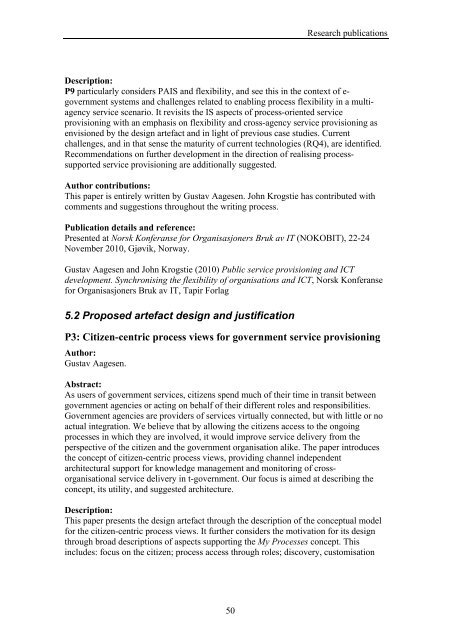Multi-channel provisioning of public services - Department of ...
Multi-channel provisioning of public services - Department of ...
Multi-channel provisioning of public services - Department of ...
Create successful ePaper yourself
Turn your PDF publications into a flip-book with our unique Google optimized e-Paper software.
Research <strong>public</strong>ations<br />
Description:<br />
P9 particularly considers PAIS and flexibility, and see this in the context <strong>of</strong> e-<br />
government systems and challenges related to enabling process flexibility in a multiagency<br />
service scenario. It revisits the IS aspects <strong>of</strong> process-oriented service<br />
<strong>provisioning</strong> with an emphasis on flexibility and cross-agency service <strong>provisioning</strong> as<br />
envisioned by the design artefact and in light <strong>of</strong> previous case studies. Current<br />
challenges, and in that sense the maturity <strong>of</strong> current technologies (RQ4), are identified.<br />
Recommendations on further development in the direction <strong>of</strong> realising processsupported<br />
service <strong>provisioning</strong> are additionally suggested.<br />
Author contributions:<br />
This paper is entirely written by Gustav Aagesen. John Krogstie has contributed with<br />
comments and suggestions throughout the writing process.<br />
Publication details and reference:<br />
Presented at Norsk Konferanse for Organisasjoners Bruk av IT (NOKOBIT), 22-24<br />
November 2010, Gjøvik, Norway.<br />
Gustav Aagesen and John Krogstie (2010) Public service <strong>provisioning</strong> and ICT<br />
development. Synchronising the flexibility <strong>of</strong> organisations and ICT, Norsk Konferanse<br />
for Organisasjoners Bruk av IT, Tapir Forlag<br />
5.2 Proposed artefact design and justification<br />
P3: Citizen-centric process views for government service <strong>provisioning</strong><br />
Author:<br />
Gustav Aagesen.<br />
Abstract:<br />
As users <strong>of</strong> government <strong>services</strong>, citizens spend much <strong>of</strong> their time in transit between<br />
government agencies or acting on behalf <strong>of</strong> their different roles and responsibilities.<br />
Government agencies are providers <strong>of</strong> <strong>services</strong> virtually connected, but with little or no<br />
actual integration. We believe that by allowing the citizens access to the ongoing<br />
processes in which they are involved, it would improve service delivery from the<br />
perspective <strong>of</strong> the citizen and the government organisation alike. The paper introduces<br />
the concept <strong>of</strong> citizen-centric process views, providing <strong>channel</strong> independent<br />
architectural support for knowledge management and monitoring <strong>of</strong> crossorganisational<br />
service delivery in t-government. Our focus is aimed at describing the<br />
concept, its utility, and suggested architecture.<br />
Description:<br />
This paper presents the design artefact through the description <strong>of</strong> the conceptual model<br />
for the citizen-centric process views. It further considers the motivation for its design<br />
through broad descriptions <strong>of</strong> aspects supporting the My Processes concept. This<br />
includes: focus on the citizen; process access through roles; discovery, customisation<br />
50
















